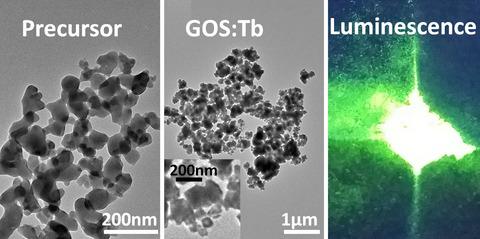当前位置:
X-MOL 学术
›
J. Am. Ceram. Soc.
›
论文详情
Our official English website, www.x-mol.net, welcomes your
feedback! (Note: you will need to create a separate account there.)
A low temperature approach for photo/cathodoluminescent Gd2O2S:Tb (GOS:Tb) nanophosphors
Journal of the American Ceramic Society ( IF 3.5 ) Pub Date : 2018-12-21 , DOI: 10.1111/jace.16190 Xuejiao Wang 1, 2 , Qinghong Meng 3, 4 , Meiting Li 2, 3, 4 , Xiaojun Wang 5 , Zhihao Wang 2, 3, 4 , Qi Zhu 3, 4 , Ji‐Guang Li 2
Journal of the American Ceramic Society ( IF 3.5 ) Pub Date : 2018-12-21 , DOI: 10.1111/jace.16190 Xuejiao Wang 1, 2 , Qinghong Meng 3, 4 , Meiting Li 2, 3, 4 , Xiaojun Wang 5 , Zhihao Wang 2, 3, 4 , Qi Zhu 3, 4 , Ji‐Guang Li 2
Affiliation

|
Titrating the aqueous solution of equimolar RE(NO3)3 and (NH4)2SO4 with NH4OH to pH~9 at ~4°C produced an amorphous precursor that yielded phase‐pure and well‐dispersed RE2O2S nanopowder (RE = Gd0.99Tb0.01; GOS:Tb) via a RE2O2SO4 intermediate upon annealing in H2. The powders calcined at the typical temperatures of 700/1200°C exhibited unimodal size distributions and have the average crystallize sizes of ~17/55 nm, average particle sizes of ~284/420 nm, and specific surface areas of ~14.62/4.53 m2/g (equivalent particle sizes: ~56/180 nm). The 1200°C product exhibited sharp green luminescence at ~544 nm (FWHM = 2.3 nm; λex = 275 nm), with an absolute quantum yield of ~24.8% and a fluorescence lifetime of ~1.34 ms at room temperature. It was also shown that the powder possesses favorable thermal stability (the activation energy for thermal quenching of luminescence ~0.305 eV) and is stable under electron beam irradiation up to 7 kV and 50 μA. The synthetic technique has the advantages of scalability and favorable dispersion and high chemical/phase purity for GOS powder, which may allow the sintering of scintillation ceramics at lower temperatures.
中文翻译:

光/阴极发光Gd2O2S:Tb(GOS:Tb)纳米磷光体的低温方法
在约4°C下用NH 4 OH滴定等摩尔RE(NO 3)3和(NH 4)2 SO 4的水溶液至pH〜9,产生无定形前体,产生纯相和分散良好的RE 2 O 2通过在H 2中退火时经由RE 2 O 2 SO 4中间体形成的S纳米粉(RE = Gd 0.99 Tb 0.01; GOS:Tb)。在700/1200°C的典型温度下煅烧的粉末表现出单峰尺寸分布,平均结晶尺寸为〜17/55 nm,平均粒径为〜284/420 nm,比表面积为〜14.62 / 4.53 m 2 / g(等效粒径:〜56/180 nm)。在1200℃在产品544〜纳米(FWHM = 2.3处具有尖锐的绿色发光; λ EX = 275 nm),绝对量子产率为〜24.8%,室温下的荧光寿命为〜1.34 ms。还显示出该粉末具有良好的热稳定性(用于发光的热猝灭的活化能〜0.305eV),并且在高达7kV和50μA的电子束辐射下是稳定的。该合成技术具有可扩展性和良好的分散性以及GOS粉末的化学/相纯度高的优点,这可以使闪烁陶瓷在较低的温度下烧结。
更新日期:2018-12-21
中文翻译:

光/阴极发光Gd2O2S:Tb(GOS:Tb)纳米磷光体的低温方法
在约4°C下用NH 4 OH滴定等摩尔RE(NO 3)3和(NH 4)2 SO 4的水溶液至pH〜9,产生无定形前体,产生纯相和分散良好的RE 2 O 2通过在H 2中退火时经由RE 2 O 2 SO 4中间体形成的S纳米粉(RE = Gd 0.99 Tb 0.01; GOS:Tb)。在700/1200°C的典型温度下煅烧的粉末表现出单峰尺寸分布,平均结晶尺寸为〜17/55 nm,平均粒径为〜284/420 nm,比表面积为〜14.62 / 4.53 m 2 / g(等效粒径:〜56/180 nm)。在1200℃在产品544〜纳米(FWHM = 2.3处具有尖锐的绿色发光; λ EX = 275 nm),绝对量子产率为〜24.8%,室温下的荧光寿命为〜1.34 ms。还显示出该粉末具有良好的热稳定性(用于发光的热猝灭的活化能〜0.305eV),并且在高达7kV和50μA的电子束辐射下是稳定的。该合成技术具有可扩展性和良好的分散性以及GOS粉末的化学/相纯度高的优点,这可以使闪烁陶瓷在较低的温度下烧结。

































 京公网安备 11010802027423号
京公网安备 11010802027423号